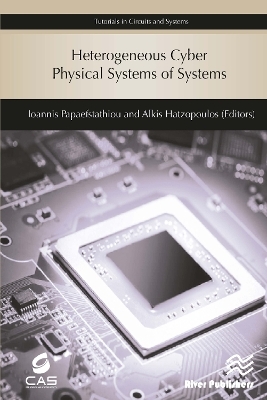
Heterogeneous Cyber Physical Systems of Systems
Seiten
2021
River Publishers (Verlag)
978-87-7022-202-0 (ISBN)
River Publishers (Verlag)
978-87-7022-202-0 (ISBN)
This book covers basic and advanced issues on the design of the future heterogeneous Cyber Physical Systems of Systems (CPSoS), including relevant Blockchain technologies, reconfigurable systems, advanced sensor interfaces and human-centered design processes.
Cyber-physical systems are the natural extension of the so-called “Internet of Things”. They are “systems of collaborating computational elements controlling physical entities”. Cyber Physical Systems of Systems (CPSoS) are considered “The Next Computing Revolution” after Mainframe computing (60’s-70’s), Desktop computing & Internet (80’s-90’s) and Ubiquitous computing (00’s); because all aspects of daily life are rapidly evolving towards humans interacting amongst themselves as well as their environment via computational devices (often mobile), and because in most cases systems will employ their computational capabilities to interact amongst themselves.
CPSoS enable the physical world to merge with the cyber one. Using sensors, the embedded systems monitor and collect data from physical processes, such as the steering of a vehicle, energy consumption or human health functions. The systems are networked making the data globally available. CPSoS make it possible for software applications to directly interact with events in the physical world, for example to measure and react to changes in blood pressure or peaks in energy consumption. Embedded hardware and software systems crucially expand the functionality and competitiveness of vehicles, aircraft, medical equipment, production plants and household appliances. Connecting these systems to a virtual environment of globally networked services and information systems opens completely new areas of innovation and novel business platforms.
Future CPSoS will have many sophisticated, interconnected parts that must instantaneously exchange, parse, and act on detailed data in a highly coordinated manner. Continued advances in science and engineering will be necessary to enable advances in design and development of these complex systems. Multi- scale, multi-layer, multi-domain, and multi-system integrated infrastructures will require new foundations in system science and engineering. Scientists and engineers with an understanding of otherwise physical systems will need to work in tandem with computer and information scientists to achieve effective, workable designs. In this tutorial, basic and advanced issues on the design of the future heterogeneous CPSoS are presented including relevant Blockchain technologies, reconfigurable systems, advanced sensor interfaces and human-centered design processes. Certain advanced tools for the design and implementation of the cyber parts of the CPSoS (i.e. FPGA design tools from Xilinx) are also covered.
Cyber-physical systems are the natural extension of the so-called “Internet of Things”. They are “systems of collaborating computational elements controlling physical entities”. Cyber Physical Systems of Systems (CPSoS) are considered “The Next Computing Revolution” after Mainframe computing (60’s-70’s), Desktop computing & Internet (80’s-90’s) and Ubiquitous computing (00’s); because all aspects of daily life are rapidly evolving towards humans interacting amongst themselves as well as their environment via computational devices (often mobile), and because in most cases systems will employ their computational capabilities to interact amongst themselves.
CPSoS enable the physical world to merge with the cyber one. Using sensors, the embedded systems monitor and collect data from physical processes, such as the steering of a vehicle, energy consumption or human health functions. The systems are networked making the data globally available. CPSoS make it possible for software applications to directly interact with events in the physical world, for example to measure and react to changes in blood pressure or peaks in energy consumption. Embedded hardware and software systems crucially expand the functionality and competitiveness of vehicles, aircraft, medical equipment, production plants and household appliances. Connecting these systems to a virtual environment of globally networked services and information systems opens completely new areas of innovation and novel business platforms.
Future CPSoS will have many sophisticated, interconnected parts that must instantaneously exchange, parse, and act on detailed data in a highly coordinated manner. Continued advances in science and engineering will be necessary to enable advances in design and development of these complex systems. Multi- scale, multi-layer, multi-domain, and multi-system integrated infrastructures will require new foundations in system science and engineering. Scientists and engineers with an understanding of otherwise physical systems will need to work in tandem with computer and information scientists to achieve effective, workable designs. In this tutorial, basic and advanced issues on the design of the future heterogeneous CPSoS are presented including relevant Blockchain technologies, reconfigurable systems, advanced sensor interfaces and human-centered design processes. Certain advanced tools for the design and implementation of the cyber parts of the CPSoS (i.e. FPGA design tools from Xilinx) are also covered.
Ioannis Papaefstathiou, Alkis Hatzopoulos
0. Introduction; 1. Meta-Arduino-ing Microcontroller-Based Cyber Physical System Design; 2. Adaptivity and self-awareness of CPSs and CPSoSs; 3. The use of Blockchain in supply chain management; 4.Edge Intelligence – How to design Efficient Intelligent Edge devices; 5. Putting the humans in the middle of the CPS design process; 6. Design of scalable sensor interface circuits for a smart world; 7. Powering Cyber-Physical-System nodes by Energy Harvesting; 8. Hands on Hardware/Software Co-Design
| Erscheinungsdatum | 21.08.2020 |
|---|---|
| Reihe/Serie | Tutorials in Circuits and Systems |
| Verlagsort | Gistrup |
| Sprache | englisch |
| Maße | 156 x 232 mm |
| Themenwelt | Informatik ► Theorie / Studium ► Kryptologie |
| Technik ► Elektrotechnik / Energietechnik | |
| ISBN-10 | 87-7022-202-9 / 8770222029 |
| ISBN-13 | 978-87-7022-202-0 / 9788770222020 |
| Zustand | Neuware |
| Haben Sie eine Frage zum Produkt? |
Mehr entdecken
aus dem Bereich
aus dem Bereich
Geschichte, Techniken, Anwendungen
Buch | Softcover (2022)
C.H.Beck (Verlag)
9,95 €
Die faszinierende Geschichte der Verschlüsselung
Buch | Softcover (2022)
Springer (Verlag)
34,99 €


